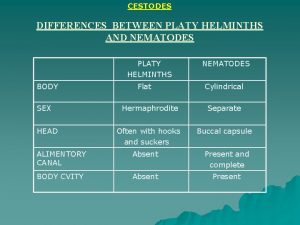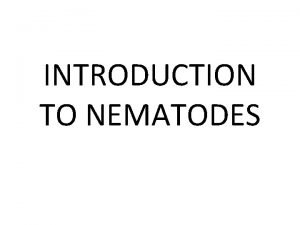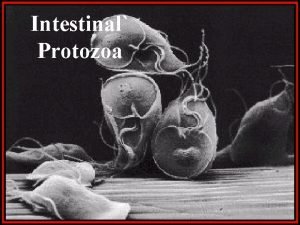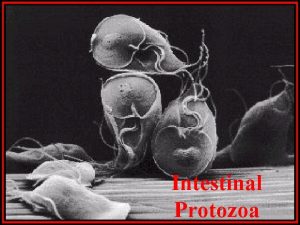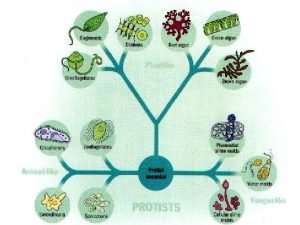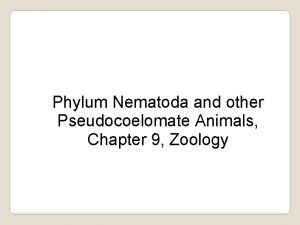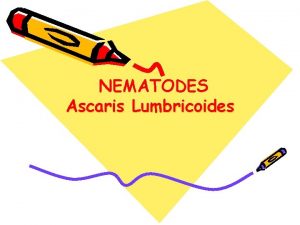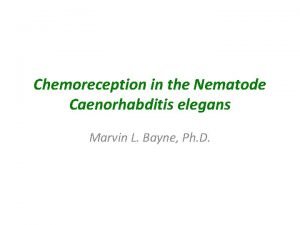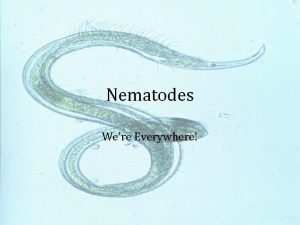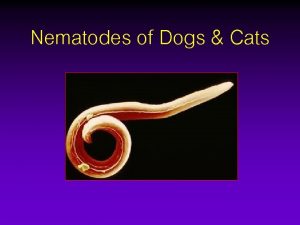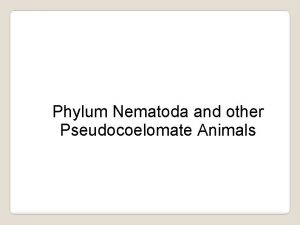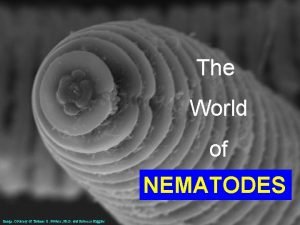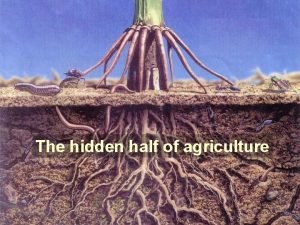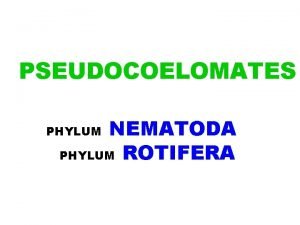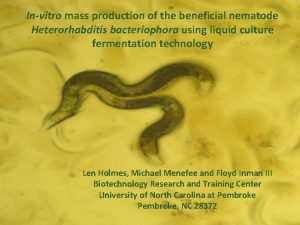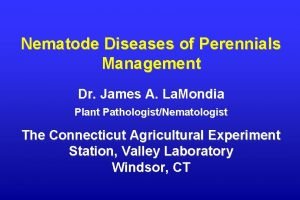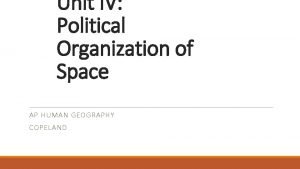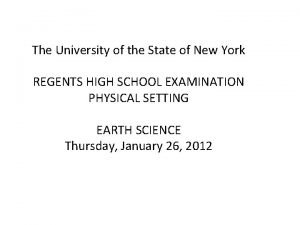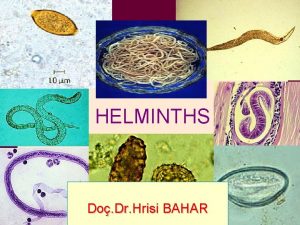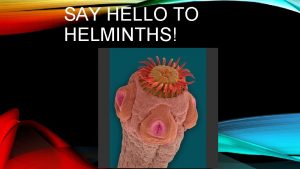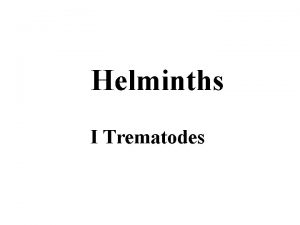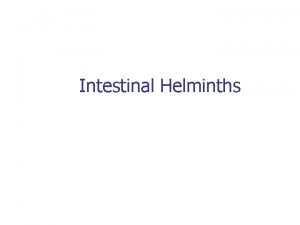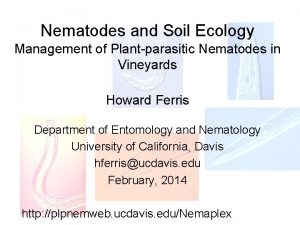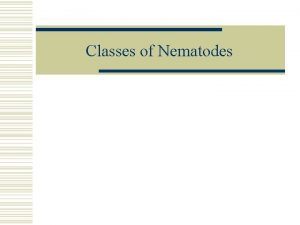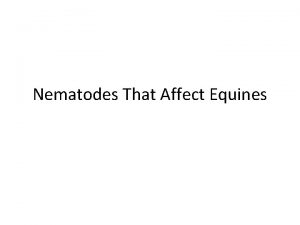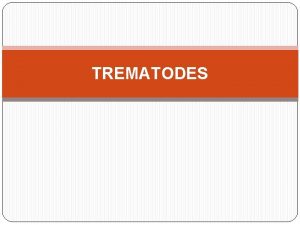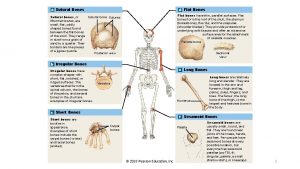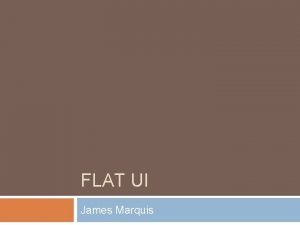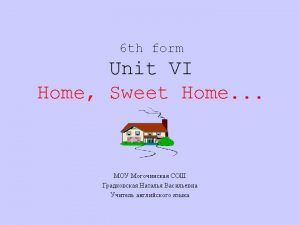INTRODUCTION TO NEMATODES Helminths are elongated flat or






















- Slides: 22

INTRODUCTION TO NEMATODES

• Helminths are elongated flat or round worm like parasites. • They are eukaryotic multicellular and bilaterally symmetrical. • Belong to two phyla—Platyhelminths (three class —Cestoidea, Trematodea and Monogenea Phylum--Nemathelminthis • Most wide spread animal group in world. • Many non pathogenic---free living forms in fresh or marine water and soil. • Few parasite human , animals and plants.

Systemic classification • Based on Anderson-----Phylum nematoda has two classes Androphorea and Secermentia Evolutionary more developed from Platyhelminthis Posses definitive body cavity(space b/w body wall and alimentary canal) Alimentary canal starts from mouth-oesophagusintestine and anus Diecious , rudimentary nervous and excretory system

Classification • Based on habitat---mostly in intestine , some resides in tissue. • Based on they lay egg or larva---Ovparous Viviparous Ovoviviparous

Classification based on habitat Intestinal human nematodes Somatic human nematodes Animal nematodes infecting human rarely Small intistine Filarial form Larva migrans Other animal nematodes Ascaris lumbicoides (common round worm) Lymphatics Wuchereria bancropti Brugia malai Brugia thimori Visceral Toxocara(Lv) Angiostrngylus cotonensis(cns) Zoonotic Dirofilaria Ancylostoma duodenale (old world hook worm) Skin Loa loa Oncchocerca Monsonella streptocerca Monsonella azzardi (serous cavity Monsonella perstans A. Costariensi(abdomen) Anisaki Baylisascriasis Cutaneous A. brasiliansis A. Caninum A. Cyalesium Gnanthostoma Bunastomum Intestine C. Philippinensis Tricostrongylus S. Fuellbormi Teraidens spp Cojuctiva Thelezia spp Liver C. Hepatica Kidney Dictophyma spp Necator americana (new world hook worm) Trichinella spiralis Dracanculosis medinensis Large intestine Trichuris trichura Enterobius vermiculasis RT A. Suum c. aerophla

oviparous • Most are oviparous---following fertilization female produce eggs that take some time to hatch to form larva. Eggs with segmented ovum—Hook worm , Trichostrongyloides spp Eggs with unsegmented ovum---Ascaris spp Eggs with unsegmented ovum with mucus plug at both the poles---Trichuris spp Eggs contain larva that takes some time to hatch--EV

VIVIPAROUS • Female worm directly give birth to larvae-no egg stage Filarial worm , Trichinella spp, Dracunculosis spp

OVOVIVIPAROUS • Female lay eggs containing larvae that immediately hatch out Strongyloides spp

GENERAL DESCRIPTION • Pass through six developmental stages—adult worm-egg- and four larvae L 1—L 4 • Each larval stage transforms to the next by shedding of the cuticle (Moulting).

Adult worm • Elongated cylindrical or filiform in shape with both ends pointed. • Unsegmented without any appendages. • Size—less than 5 mm ( hookworm, trichinella, strngyloides) to As long as one meter(Dracunculosis) • Body bilaterally and head is radially symmetrical



• Body wall-made of outer layer of tough acellular cuticle and inner layer of longitudinal muscle. • Move by contraction of longitudinal muscles. • Alimentary canal---well developed---mouth at anterior end-followed by muscular glandular oesophagus-intestine –rectum-sub terminal anus at posterior end • In some species mouth bears teeth (cutting plate )—hook worm • Oesophagus in some may bear posterior bulb (Enterobius vermicularis • Mid gut lined by columnar epithelium.

• Body cavity---has body cavity or pseudocele with high hydrostatic pressure---filled with body fluids secreted by intestine or genital organs • Sexes---diecious


Male reproductive system • consist of long convoluted tube which can be differenciated into testes , vas differens, seminal vesicle and ejaculatory duct. • Some also bears accessory copulatory organs like copulatory bursa with two spicules and gubernaculum. • Ejaculatory duct opens subterminally at posterior end into a common passage along with the rectum (Cloca)


Female reproductive system • Consisting of two( columns) or one convoluted tube—each tube differentiated into an ovary , oviduct , seminal receptacals and uterus and the both tubes joined to form a common vagina that open through vulva (genital pore ) either in the middle of body or near mouth.

Nervous system • Rudimentary---circular nerve ring surrounding oesophagus and six longitudinal nerve trunks (1 d 1 v 4 l ) • D- motar , L-sensory and V-combines both • Some may have sensory structure like—sensory papillae and phasmid over cuticle

Excretory system • Rudimentary-no flame cells • Various organs for waste disposal Through anus Nitrogen waste through body wall H shaped canal along each side of body regulate nutrients and waste contents An excretory gland near oesophagus

Life cycle • Only one host except Filarial worm (Man and Mosquitoes) and Dracunculosis(Man and Cyclops )

Difference b/w Cestode Trematode Nematode Properties Cestodes Trematodes Nematodes Shape Tape like , segmented Leaf , unsegment Elongated, cylindrical. unsegmentd Head end Suckers present , some hooklets Sucker present , no hooklets No sucker no hooklet some have devp buccal cavity Alimentary canal Absent Present incomplete Complete with mouth Body cavity “ Absent Present Sexes Monoecious Monecious exceptschistosomes Diecious Life cycle and Larval foms Two host , except D. latum and H. nana Cysticercous Hydatid cyst, coencircus, cystcerco id , corcidium procercoid and plerocercoid Three host excepr schistosomes Cercaria metacercaria radia miracidium and sporocyst One host except filarial worm and dracunculosis Rhabditiform Filariform Microfilaria
 Helminths and nematodes
Helminths and nematodes Antigentest åre
Antigentest åre In nemathelminthis females are
In nemathelminthis females are Amoebiasis stool color
Amoebiasis stool color Giardia cyst and trophozoite
Giardia cyst and trophozoite Are protists polyphyletic
Are protists polyphyletic Phylum nematoda anatomy
Phylum nematoda anatomy Nematoda
Nematoda Characteristics of nematodes
Characteristics of nematodes Renette cells in nematodes
Renette cells in nematodes Nematodes interesting facts
Nematodes interesting facts Morphology of nematodes
Morphology of nematodes Spirocerca lupi
Spirocerca lupi Alimentary canal of nematodes
Alimentary canal of nematodes Nematoda annelida
Nematoda annelida Nematodes
Nematodes Nematodes
Nematodes Pseudocoelomate
Pseudocoelomate Excretory system of nematodes
Excretory system of nematodes Are nematodes hermaphroditic
Are nematodes hermaphroditic Foliar nematodes treatment
Foliar nematodes treatment Centrifugal force ap human geography
Centrifugal force ap human geography The elongated hills labeled r
The elongated hills labeled r
